Abstract
1. The effect of chlorpromazine (CPZ) on the metabolism of dopamine and 5-hydroxytryptamine in dog brain was investigated by following the concentrations of the acid metabolites of these amines, homovanillic acid, 3,4-dihydroxyphenylacetic acid and 5-hydroxyindolylacetic acid, in the ventricular cerebrospinal fluid (C.S.F.) of dogs over a period of 5 hr after intravenous administration of CPZ (2·5, 5, 10 and 15 mg/kg), using the technique of serial sampling of lateral ventricular C.S.F. “Low” doses (2·5-10 mg/kg) produced a rise in the concentration of homovanillic acid and smaller increases in the concentrations of 3,4-dihydroxyphenylacetic acid and 5-hydroxyindolylacetic acid. “High” doses (10-15 mg/kg) had a lesser effect on the concentration of homovanillic acid and had no effect on, or decreased, the concentrations of 3,4-dihydroxyphenylacetic acid and 5-hydroxyindolylacetic acid. The concentration of 3,4-dihydroxyphenylacetic acid was maximal in the ventricular C.S.F. 2 hr after CPZ 5 mg/kg and was unaltered from the control level 2 hr after 15 mg/kg.
2. The effects on the metabolism of brain amines of CPZ (5 mg/kg), doses which the serial sampling of C.S.F. experiments had indicated as producing maximal and minimal effects on dopamine metabolism in brain tissue, were studied by estimating the concentrations of adrenaline, noradrenaline, dopamine, metanephrine, methoxydopamine, homovanillic acid, 3,4-dihydroxyphenylacetic acid and 5-hydroxyindolylacetic acid in the hypothalamus, midbrain, thalamus, hindbrain, cortex, globus pallidus and caudate nucleus of control dogs and of dogs treated with CPZ intravenously 2 hr before killing. The concentrations of homovanillic acid, 3,4-dihydroxyphenylacetic acid and 5-hydroxyindolylacetic acid were estimated in samples of ventricular C.S.F. withdrawn from these dogs 2 hr after the injection of CPZ (i.e., immediately before death).
3. The following changes in concentrations were observed. Dopamine: CPZ 5 mg/kg produced no change in the concentration in the caudate nucleus, globus pallidus and midbrain and increased the concentration in the thalamus; CPZ 15 mg/kg appeared to cause a reduction in the concentration of this amine in the caudate nucleus and globus pallidus. Homovanillic acid and 3,4-dihydroxyphenylacetic acid: CPZ 5 mg/kg increased the concentrations of both acids in the caudate nucleus and had no effect on the concentrations of the acids in the globus pallidus, hypothalamus and thalamus; CPZ 15 mg/kg produced no change in the concentrations of the acids in any area of the brain. Methoxydopamine: CPZ 5 mg/kg and 15 mg/kg reduced the concentration in the caudate nucleus. Noradrenaline: The concentrations in the hypothalamus, midbrain, thalamus and hindbrain were slightly increased by CPZ 5 mg/kg and 15 mg/kg. Only in the thalamus was a statistically significant increase in noradrenaline observed.
4. It was concluded that the actions of chlorpromazine on catecholamine synthesis and metabolism in the brain of the dog are dose dependent. A dose of CPZ 5 mg/kg was postulated to have the following actions: (i) to increase dopamine synthesis; (ii) to activate mitochondrial monoamine oxidase. A dose of CPZ 15 mg/kg was postulated to act as follows: (i) to decrease dopamine synthesis; or (ii) to release dopamine from its storage sites.
5. The ratios of the concentrations of homovanillic acid, 3,4-dihydroxyphenylacetic acid and 5-hydroxyindolylacetic acid in the caudate nucleus to the concentrations of these acids in the ventricular C.S.F. were the same in the control dogs as in the dogs treated with CPZ (5 mg/kg and 15 mg/kg). It was concluded that the levels of the acid metabolites of dopamine in lateral ventricular C.S.F. reflect the levels of these acids in the caudate nucleus.
Full text
PDF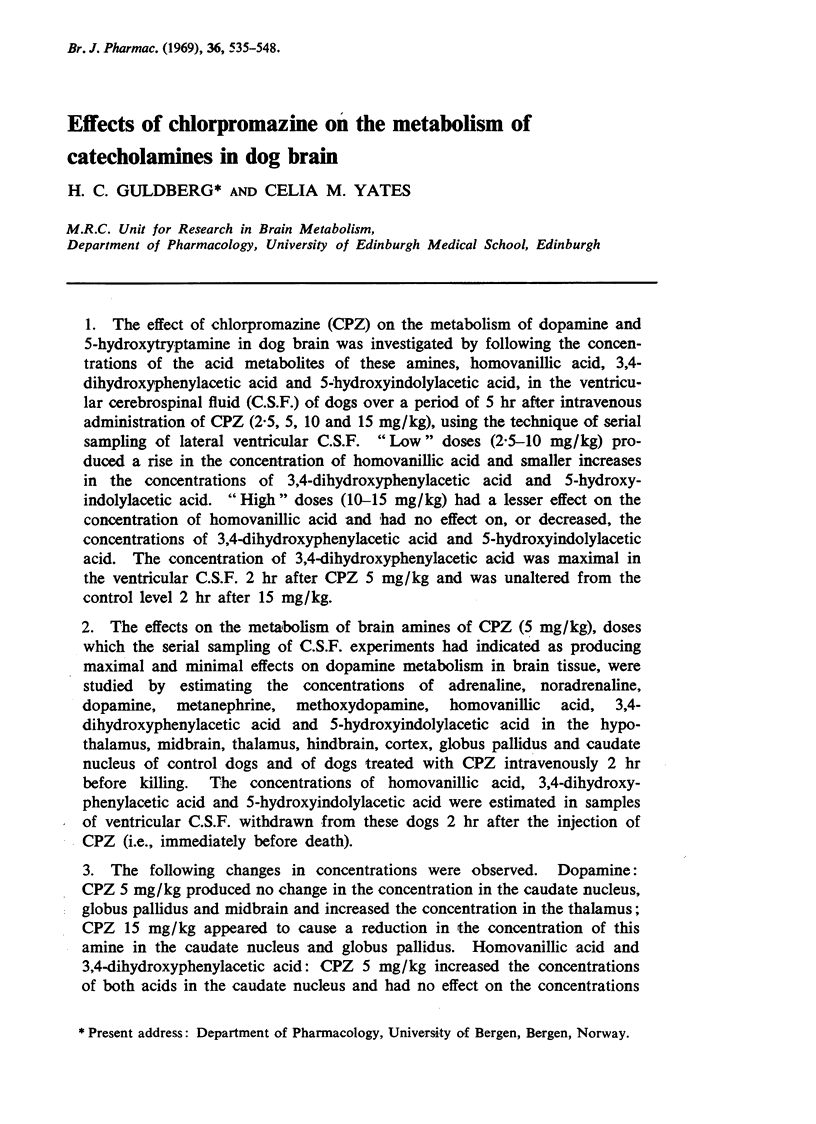
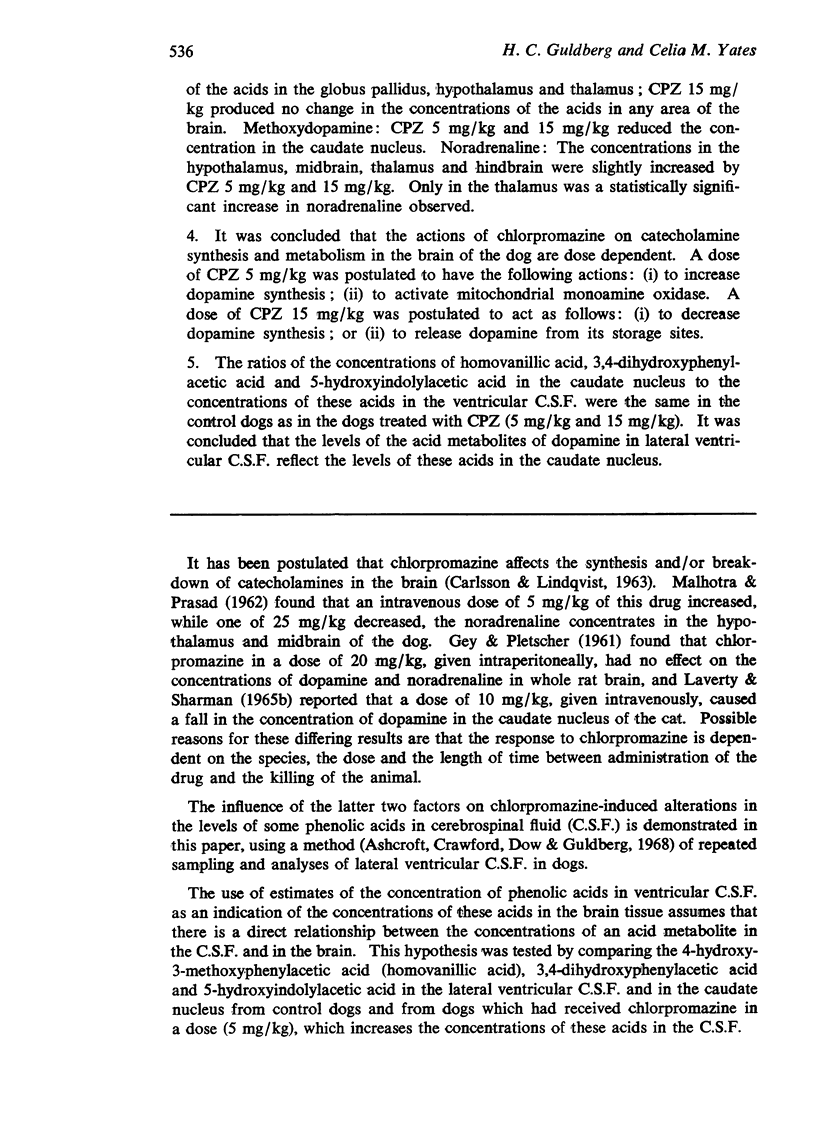
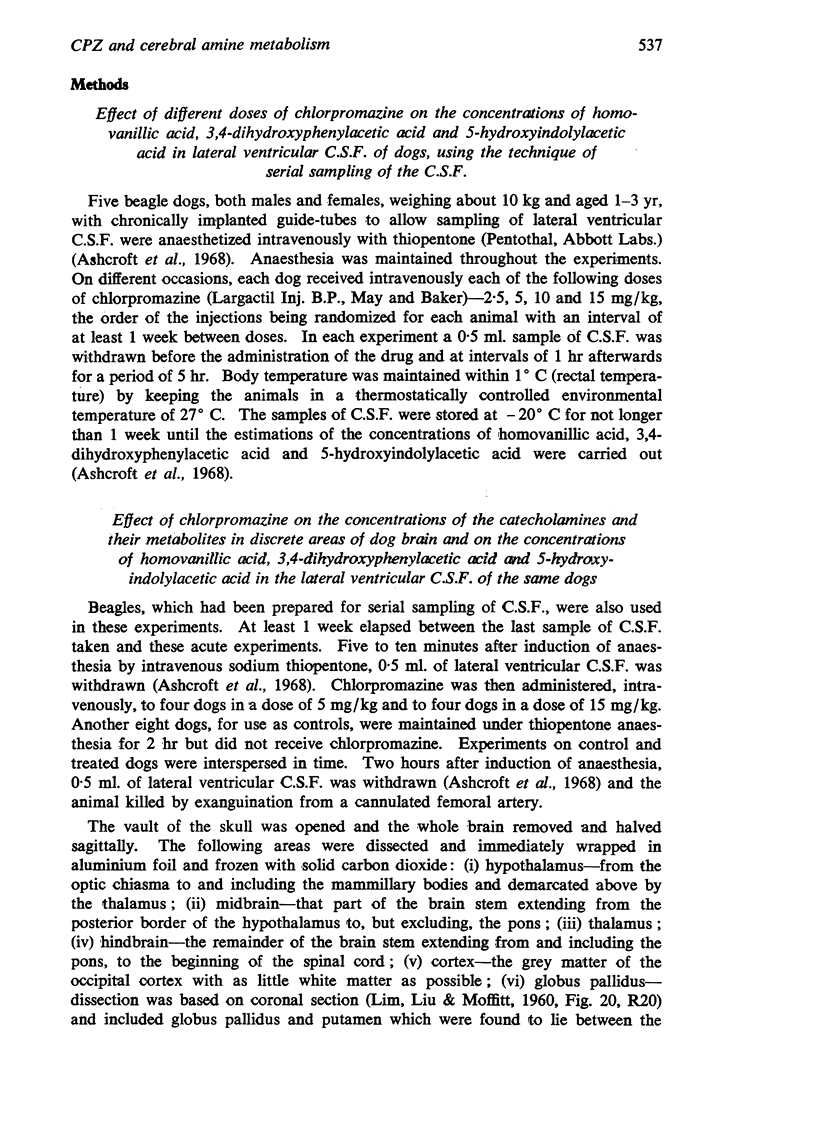
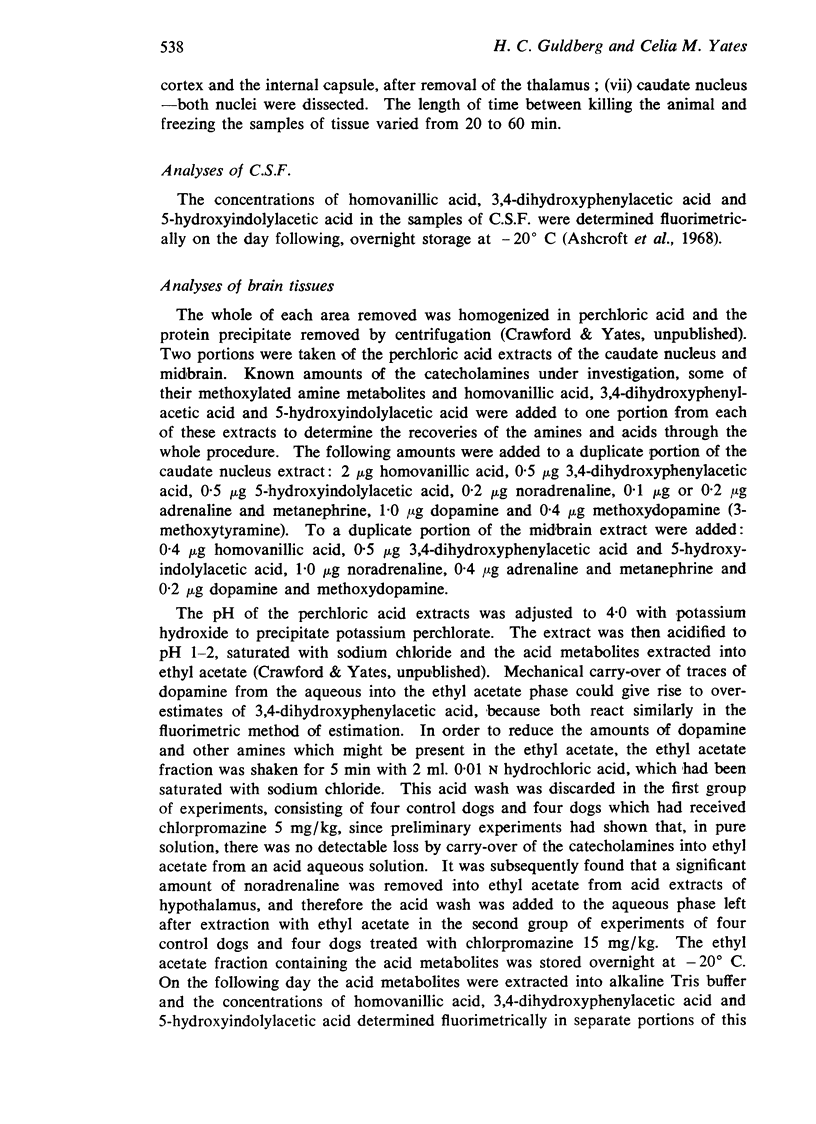
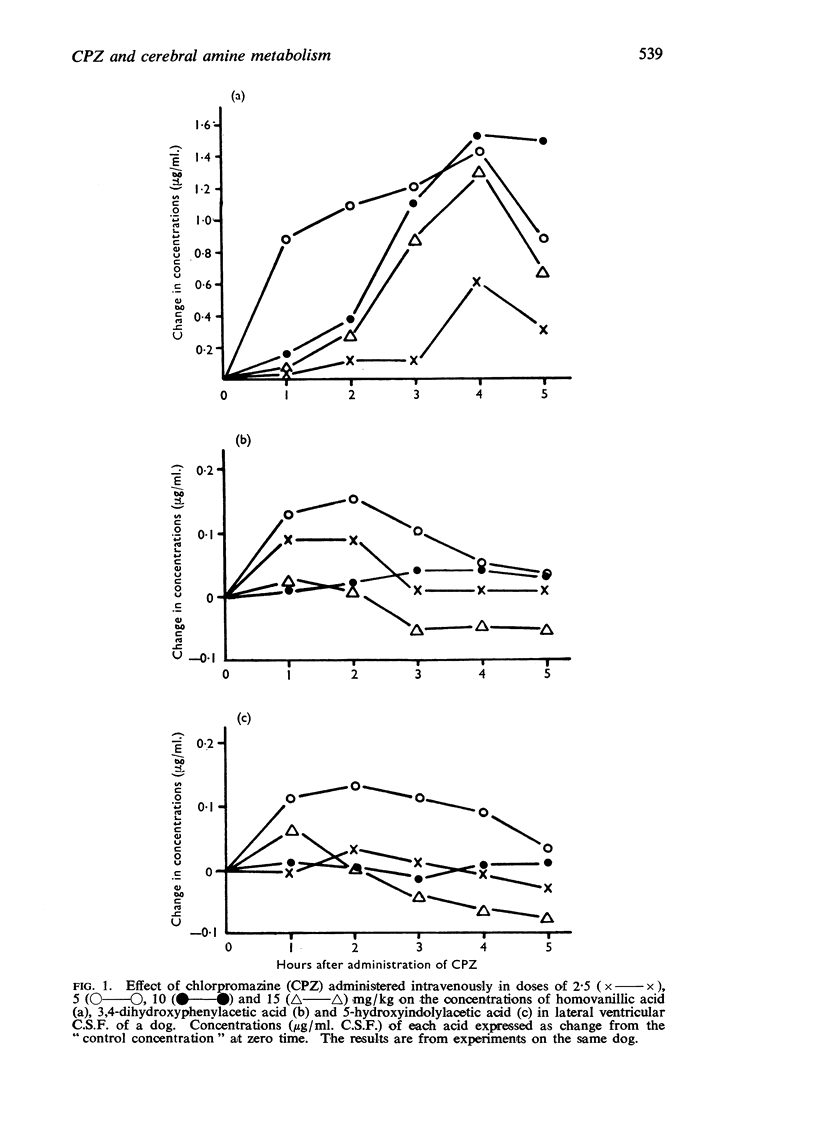
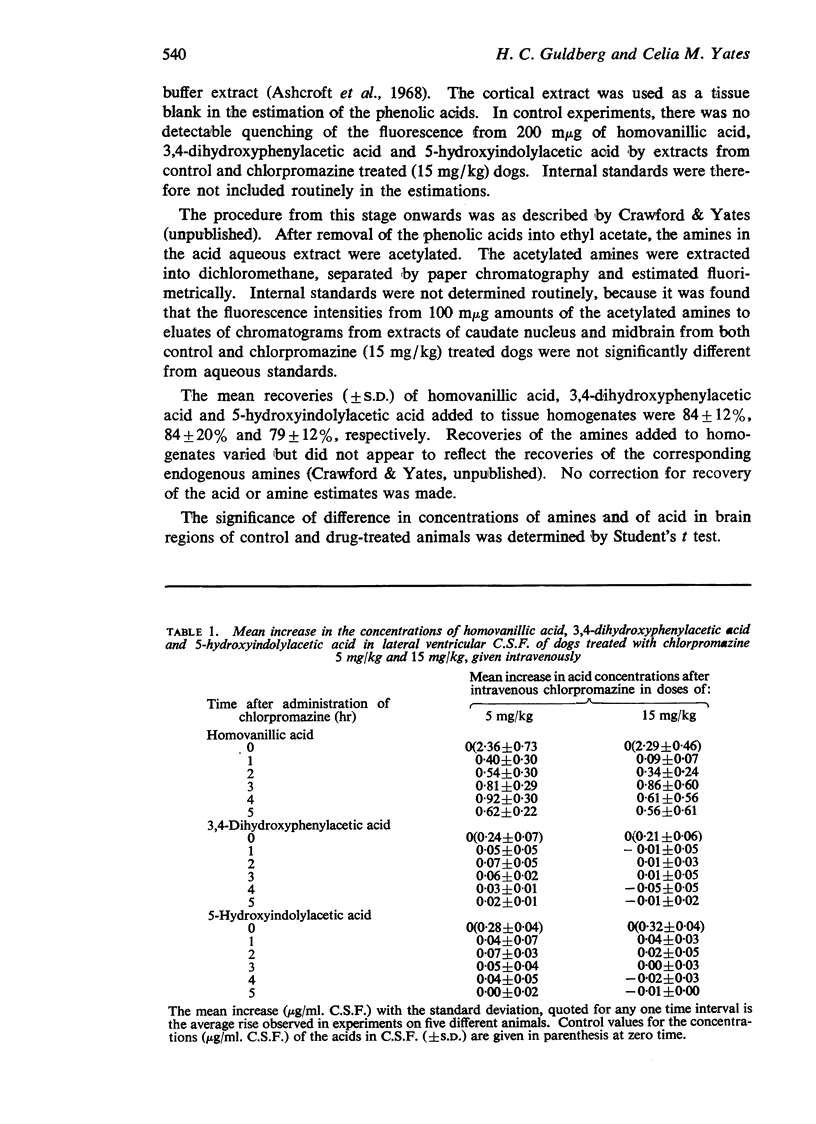
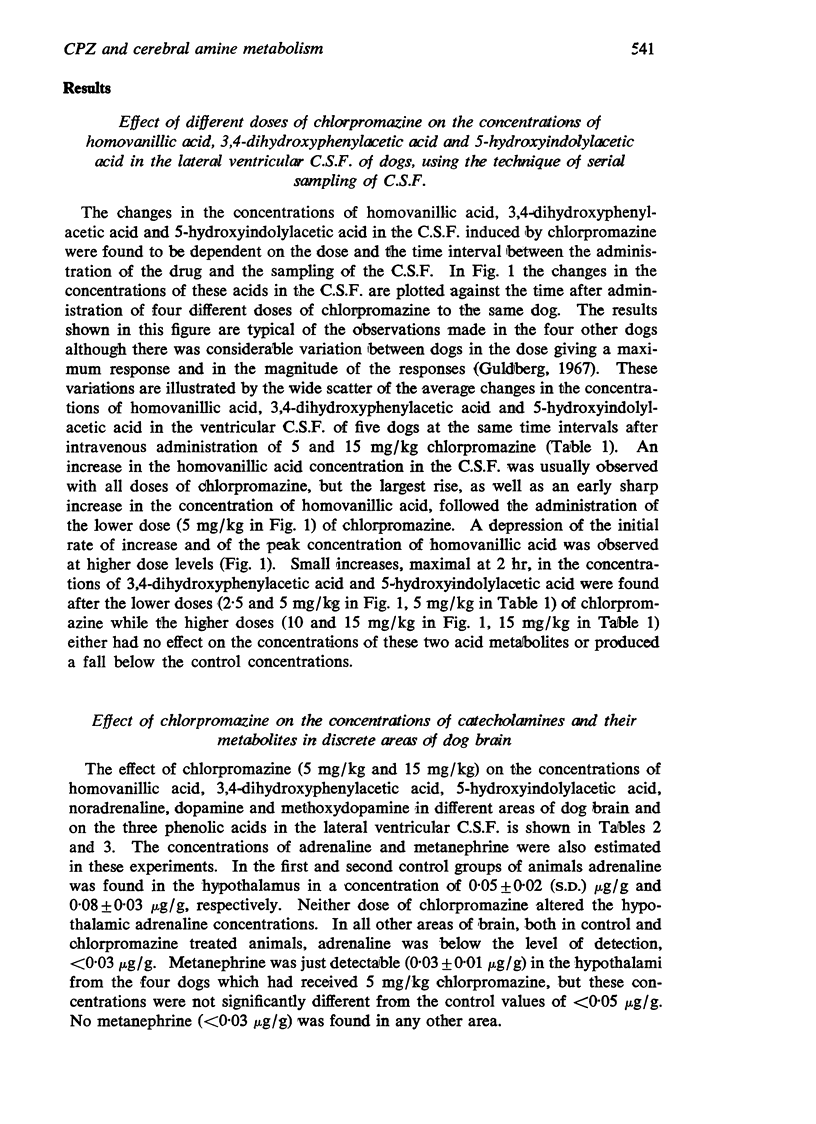
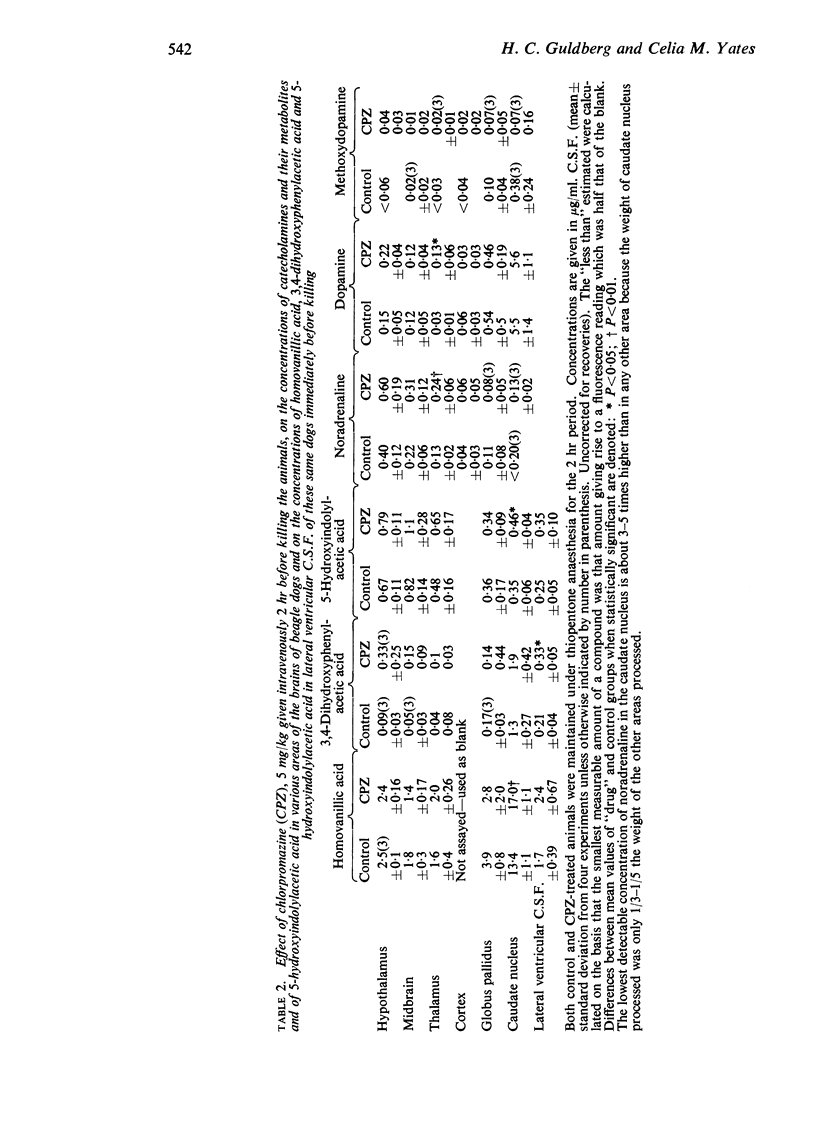
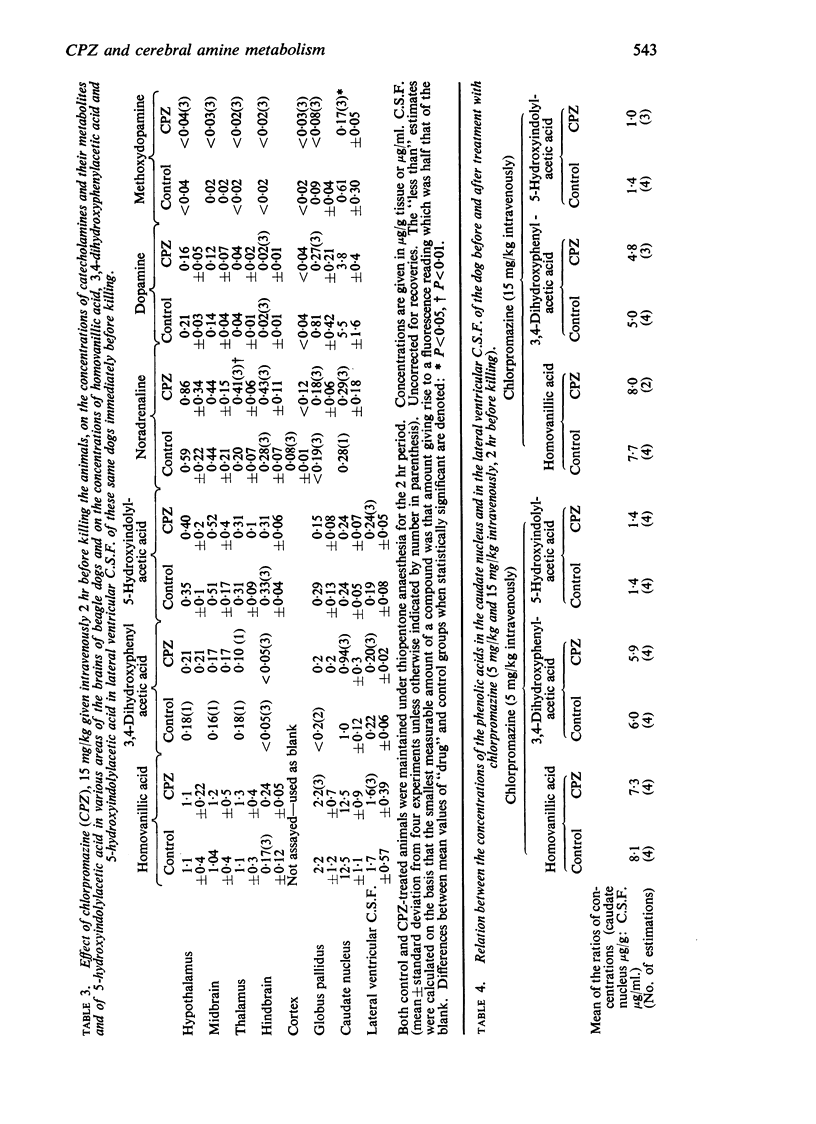
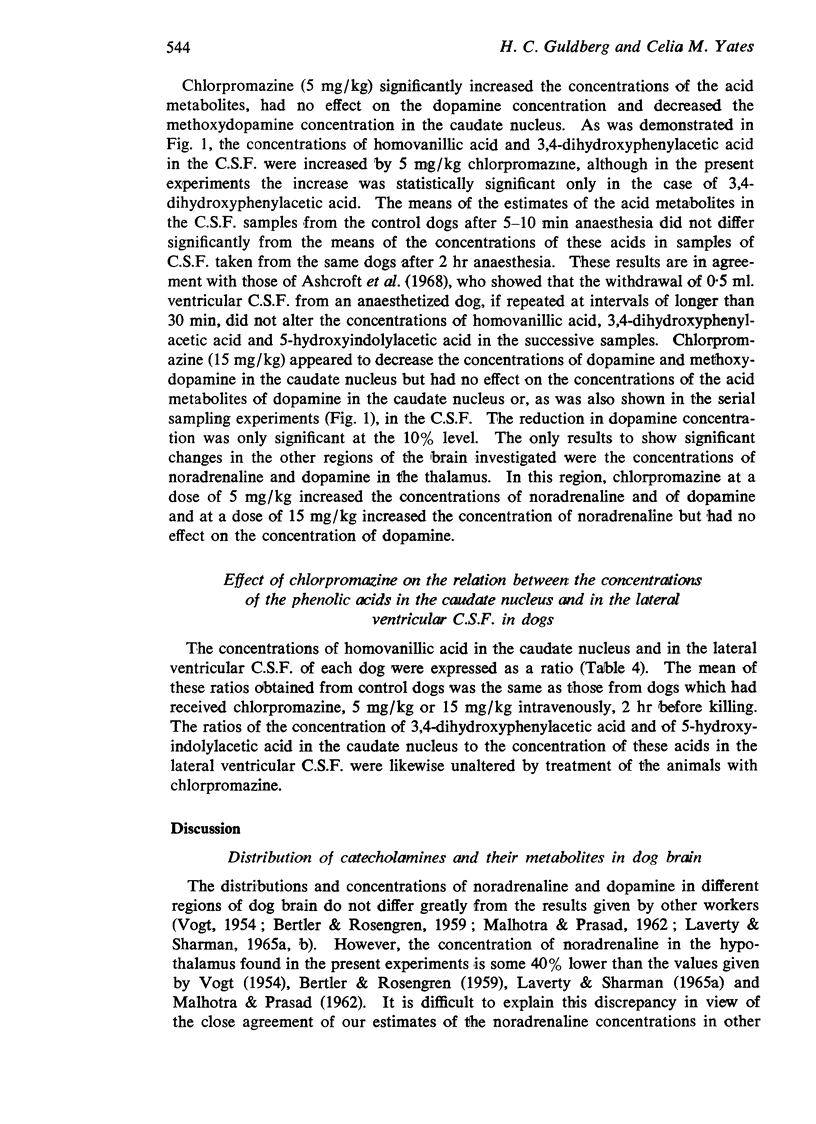
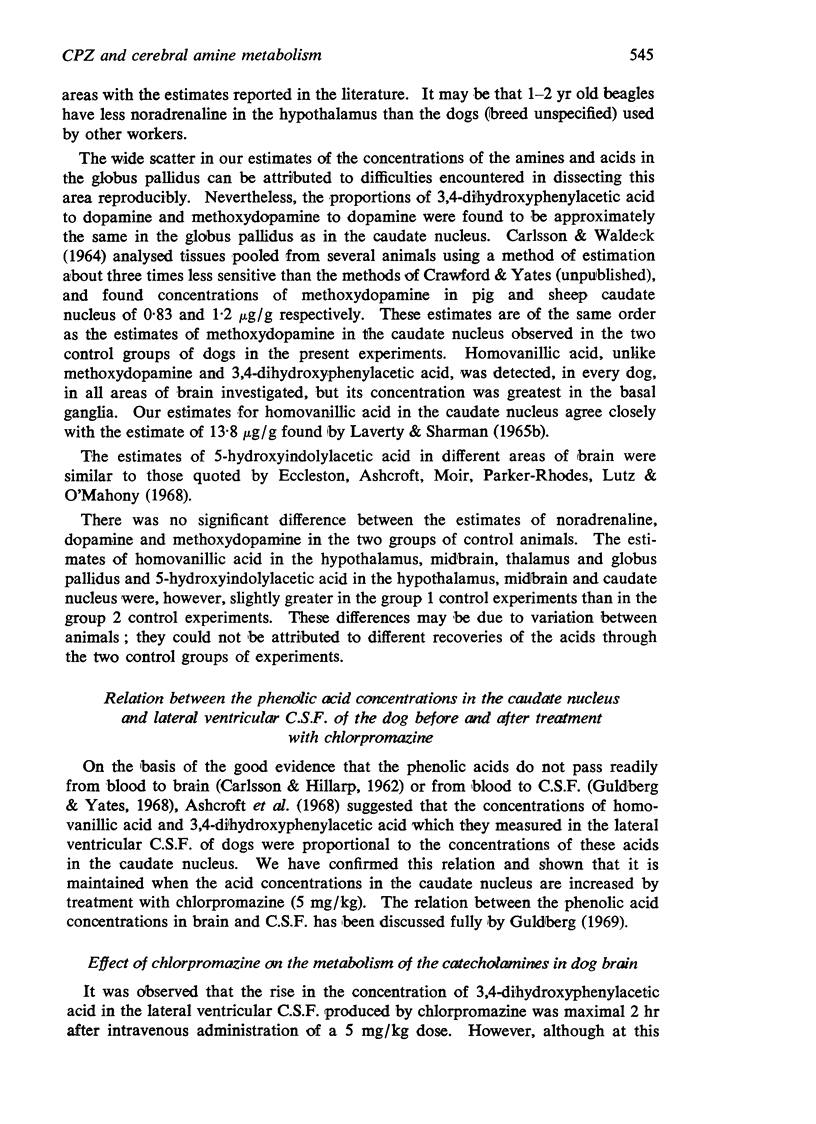

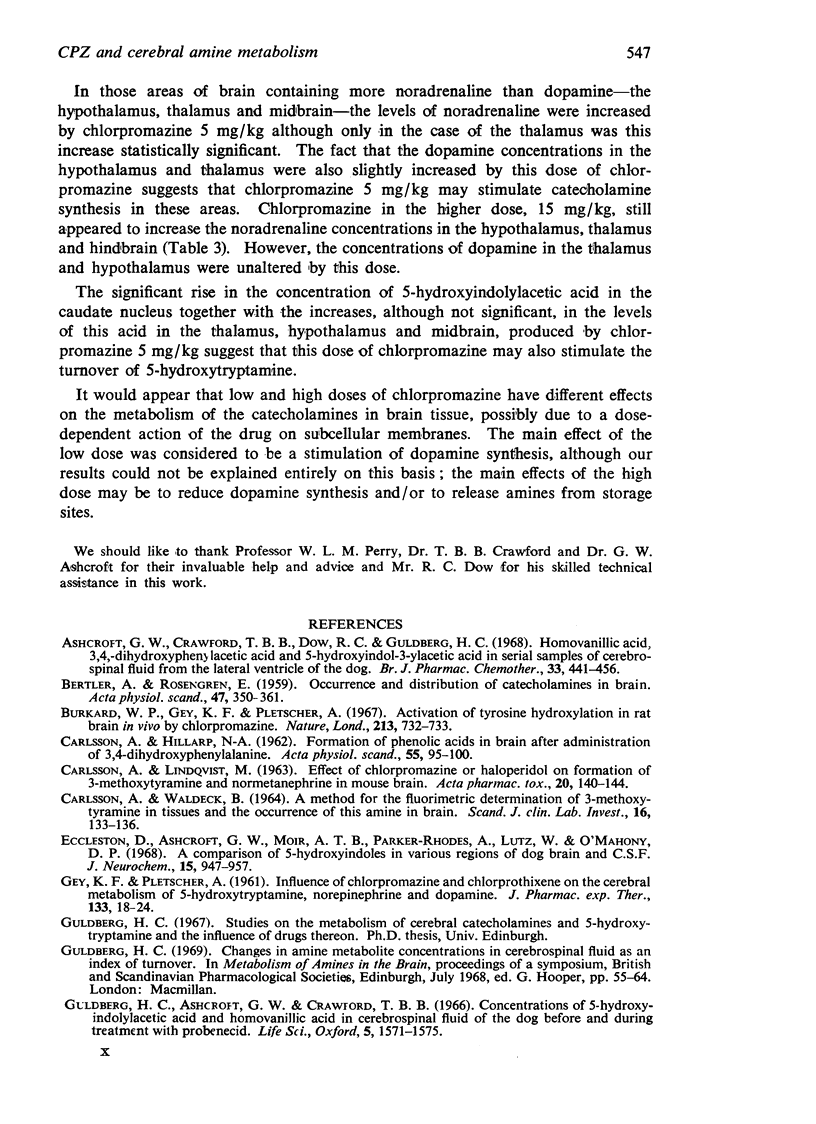
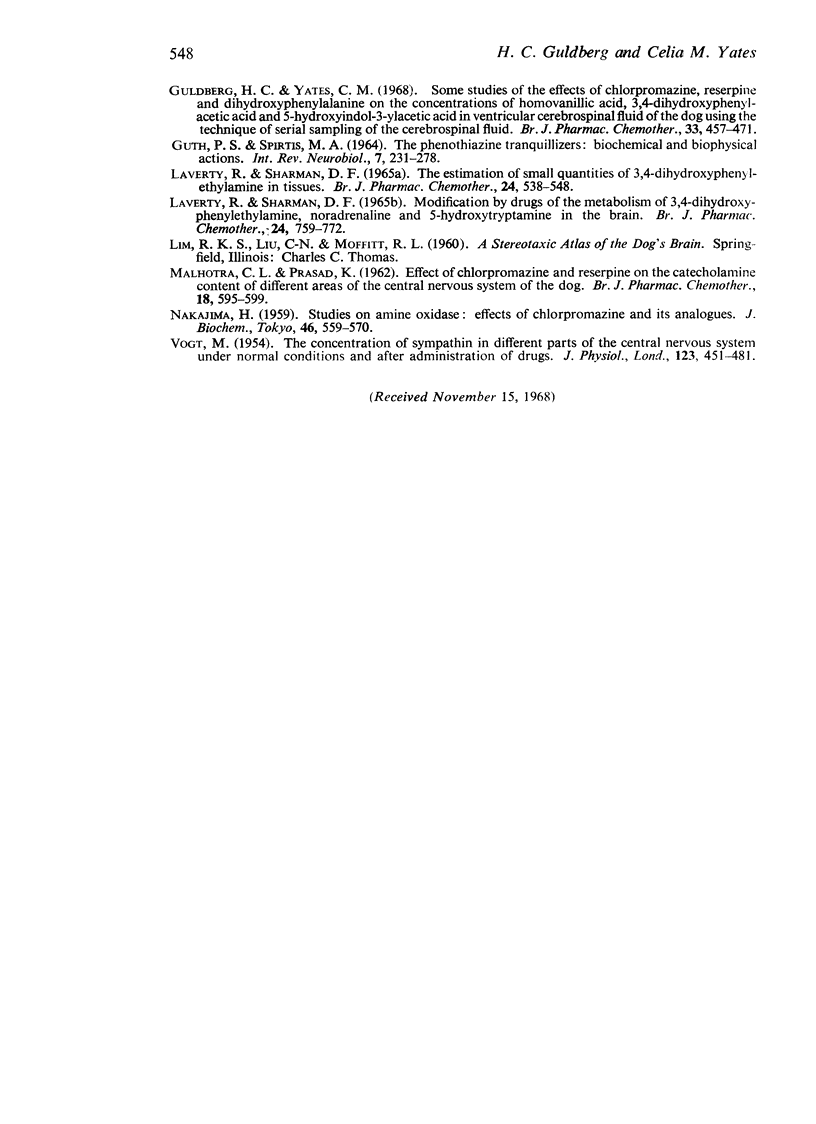
Selected References
These references are in PubMed. This may not be the complete list of references from this article.
- Ashcroft G. W., Crawford T. B., Dow R. C., Guldberg H. C. Homovanillic acid, 3,4-dihydroxyphenylacetic acid and 5-hydroxyindol-3-ylacetic acid in serial samples of cerebrospinal fluid from the lateral ventricle of the dog. Br J Pharmacol Chemother. 1968 Jul;33(3):441–456. doi: 10.1111/j.1476-5381.1968.tb00493.x. [DOI] [PMC free article] [PubMed] [Google Scholar]
- BERTLER A., ROSENGREN E. Occurrence and distribution of catechol amines in brain. Acta Physiol Scand. 1959 Dec 12;47:350–361. [PubMed] [Google Scholar]
- Burkhard W. P., Gey K. F., Pletscher A. Activation of tyrosine hydroxylation in rat brain in vivo by chlorpromazine. Nature. 1967 Feb 18;213(5077):732–733. doi: 10.1038/213732a0. [DOI] [PubMed] [Google Scholar]
- CARLSSON A., HILLARP N. A. Formation of phenolic acids in brain after administration of 3,4-dihydroxyphenylalanine. Acta Physiol Scand. 1962 May;55:95–100. doi: 10.1111/j.1748-1716.1962.tb02422.x. [DOI] [PubMed] [Google Scholar]
- CARLSSON A., LINDQVIST M. EFFECT OF CHLORPROMAZINE OR HALOPERIDOL ON FORMATION OF 3METHOXYTYRAMINE AND NORMETANEPHRINE IN MOUSE BRAIN. Acta Pharmacol Toxicol (Copenh) 1963;20:140–144. doi: 10.1111/j.1600-0773.1963.tb01730.x. [DOI] [PubMed] [Google Scholar]
- CARLSSON A., WALDECK B. A METHOD FOR THE FLUORIMETRIC DETERMINATION OF 3-METHOXYTYRAMINE IN TISSUES AND THE OCCURRENCE OF THIS AMINE IN BRAIN. Scand J Clin Lab Invest. 1964;16:133–138. doi: 10.1080/00365516409060495. [DOI] [PubMed] [Google Scholar]
- Eccleston D., Ashcroft G. W., Moir A. T., Parker-Rhodes A., Lutz W., O'Mahoney D. P. A comparison of 5-hydroxyindoles in various regions of dog brain and cerebrospinal fluid. J Neurochem. 1968 Sep;15(9):947–957. doi: 10.1111/j.1471-4159.1968.tb11637.x. [DOI] [PubMed] [Google Scholar]
- GEY K. F., PLETSCHER A. Influence of chlorpromazine and chlorprothixene on the cerebral metabolism of 5-hydroxytryptamine, norepinephrine and dopamine. J Pharmacol Exp Ther. 1961 Jul;133:18–24. [PubMed] [Google Scholar]
- GUTH P. S., SPIRTES M. A. THE PHENOTHIAZINETRANQUILIZERS: BIOCHEMICAL AND BIOPHYSICAL ACTIONS. Int Rev Neurobiol. 1964;7:231–278. doi: 10.1016/s0074-7742(08)60269-x. [DOI] [PubMed] [Google Scholar]
- Guldberg H. C., Ashcroft G. W., Crawford T. B. Concentrations of 5-hydroxyindolylacetic acid and homovanillic acid in the cerebrospinal fluid of the dog before and during treatment with probenecid. Life Sci. 1966 Sep;5(17):1571–1575. doi: 10.1016/0024-3205(66)91026-5. [DOI] [PubMed] [Google Scholar]
- Guldberg H. C., Yates C. M. Some studies of the effects of chlorpromazine, reserpine and dihydroxyphenylalanine on the concentrations of homovanillic acid, 3,4-dihydroxyphenylacetic acid and 5-hydroxyindol-3-ylacetic acid in ventricular cerebrospinal fluid of the dog using the technique of serial sampling of the cerebrospinal fluid. Br J Pharmacol Chemother. 1968 Jul;33(3):457–471. doi: 10.1111/j.1476-5381.1968.tb00494.x. [DOI] [PMC free article] [PubMed] [Google Scholar]
- LAVERTY R., SHARMAN D. F. MODIFICATION BY DRUGS OF THE METABOLISM OF 3,4-DIHYDROXYPHENYLETHYLAMINE, NORADRENALINE AND 5-HYDROXYTRYPTAMINE IN THE BRAIN. Br J Pharmacol Chemother. 1965 Jun;24:759–772. doi: 10.1111/j.1476-5381.1965.tb01632.x. [DOI] [PMC free article] [PubMed] [Google Scholar]
- LAVERTY R., SHARMAN D. F. THE ESTIMATION OF SMALL QUANTITIES OF 3,4-DIHYDROXYPHENYLETHYLAMINE IN TISSUES. Br J Pharmacol Chemother. 1965 Apr;24:538–548. doi: 10.1111/j.1476-5381.1965.tb01744.x. [DOI] [PMC free article] [PubMed] [Google Scholar]
- MALHOTRA C. L., PRASAD K. Effect of chlorpromazine and reserpine on the catechol amine content of different areas of the central nervous system of the dog. Br J Pharmacol Chemother. 1962 Jun;18:595–599. doi: 10.1111/j.1476-5381.1962.tb01178.x. [DOI] [PMC free article] [PubMed] [Google Scholar]
- VOGT M. The concentration of sympathin in different parts of the central nervous system under normal conditions and after the administration of drugs. J Physiol. 1954 Mar 29;123(3):451–481. doi: 10.1113/jphysiol.1954.sp005064. [DOI] [PMC free article] [PubMed] [Google Scholar]


